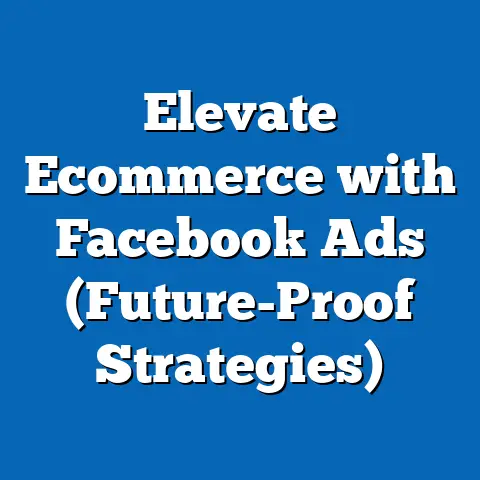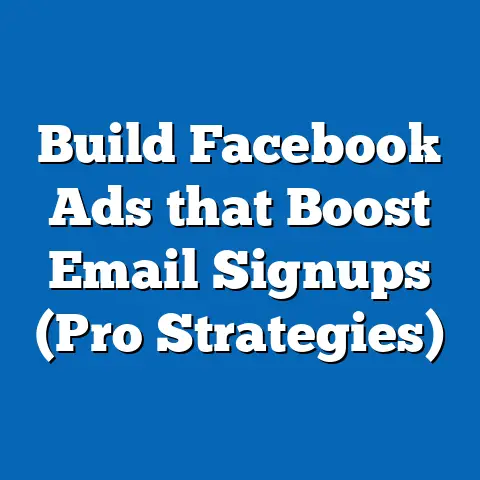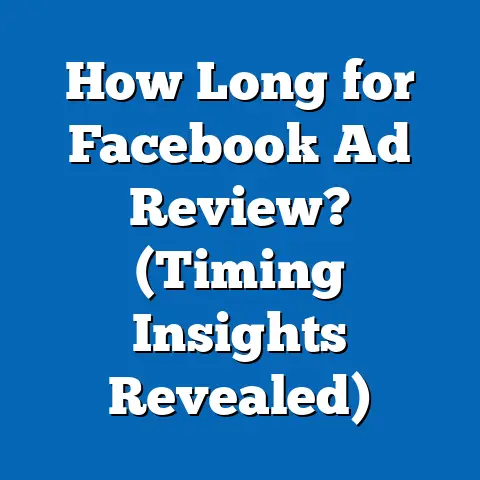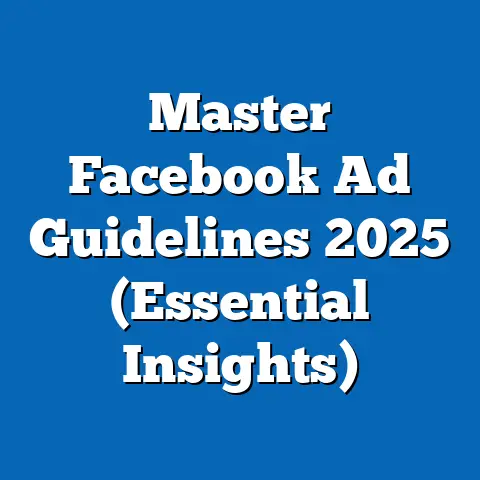Boost Catering Business with Targeted Facebook Ads (Proven Strategies)
In today’s fast-paced, health-conscious society, catering businesses that emphasize nutritious, high-quality food options are carving out a significant niche in the market. This article explores how such businesses can leverage targeted Facebook advertising to reach their ideal customer base, focusing on health-conscious demographics. By understanding the demographic makeup, core beliefs, voting patterns, and distinguishing characteristics of this group, catering businesses can craft effective marketing strategies that resonate with their values and needs.
Before diving into the specifics of Facebook advertising strategies, it’s essential to analyze the health-conscious demographic that often forms the core clientele of catering businesses focused on wellness. This group is not just a consumer segment but a cultural and political force with distinct traits that set them apart from other populations. Their preferences and behaviors offer valuable insights for businesses aiming to tailor their services and marketing efforts.
Part 1: Understanding the Health-Conscious Demographic
Demographic Composition
The health-conscious demographic in the United States is diverse but exhibits clear patterns in age, income, education, and geographic distribution. According to a 2022 Nielsen report, approximately 54% of Americans aged 18-34 prioritize health and wellness in their food choices, compared to 38% of those over 55. This younger cohort often includes millennials and Gen Z individuals who are more likely to reside in urban or suburban areas, with higher concentrations in coastal states like California and New York.
Education also plays a significant role, as data from the Pew Research Center (2021) indicates that 62% of college-educated adults are more likely to seek out organic or locally sourced foods compared to 41% of those with a high school diploma or less. Income levels further shape this group, with households earning above $75,000 annually being 30% more likely to invest in premium health foods, per a 2023 Statista survey. Racial and ethnic breakdowns show a slight overrepresentation of White and Asian Americans in this demographic, though health consciousness is growing across all groups, particularly among Hispanic Americans, who reported a 15% increase in prioritizing healthy eating from 2018 to 2022 (Nielsen, 2022).
Core Beliefs and Values
At the heart of the health-conscious demographic is a commitment to personal well-being, environmental sustainability, and ethical consumption. A 2021 Gallup poll found that 73% of this group believes in the importance of consuming organic or non-GMO foods, while 68% express concern about the environmental impact of food production. These values often extend beyond diet to include support for sustainable farming practices and opposition to industrial agriculture.
This demographic also tends to value transparency in food sourcing and preparation, with 64% indicating they are willing to pay a premium for products with clear labeling, according to a 2022 Mintel report. Their beliefs often align with broader social causes, such as animal welfare and reducing carbon footprints, which influence their purchasing decisions and brand loyalties.
Voting Patterns and Political Engagement
Politically, the health-conscious demographic leans toward progressive or liberal ideologies, though there is notable diversity within the group. Data from the 2020 American National Election Study shows that 58% of individuals who prioritize health and wellness voted for Democratic candidates, compared to 35% for Republican candidates. This trend is particularly pronounced among younger voters and those with higher education levels, with 65% of college-educated health-conscious individuals identifying as Democrats or independents leaning left.
Geographic differences also influence voting patterns, as urban health-conscious voters are 20% more likely to support progressive policies on environmental regulation and healthcare reform than their rural counterparts (Pew Research Center, 2021). However, political engagement varies, with only 45% of this demographic actively participating in local or national advocacy for food policy reform, per a 2022 CivicScience survey. This suggests a gap between personal values and collective political action.
Distinguishing Features Compared to Other Groups
Compared to the general population, the health-conscious demographic stands out for its emphasis on preventative health and lifestyle choices. While the average American spends about 10% of their income on food, health-conscious individuals allocate up to 15%, often prioritizing quality over quantity (Bureau of Labor Statistics, 2022). Unlike cost-driven consumers, who prioritize affordability (comprising about 60% of the population per Nielsen, 2022), this group values nutritional content and ethical production over price.
Additionally, their digital savviness sets them apart from less tech-oriented groups. A 2023 eMarketer report notes that 78% of health-conscious individuals aged 18-44 use social media platforms like Facebook and Instagram to research food trends and discover new brands, compared to 55% of the general population. This reliance on digital platforms makes them an ideal target for online advertising campaigns.
Intersections with Age, Education, Race, and Religion
Age significantly shapes health consciousness, with younger generations showing greater concern for diet-related health outcomes. For instance, 67% of Gen Z consumers report following specific dietary trends (e.g., veganism or gluten-free), compared to 42% of Baby Boomers (Mintel, 2022). Education correlates strongly with health awareness, as those with postgraduate degrees are twice as likely to advocate for organic foods as those without a college education (Pew Research Center, 2021).
Racially, while White Americans make up a plurality of this demographic (60%), health consciousness is rising fastest among Hispanic and Black communities, with a 12% and 10% increase, respectively, in prioritizing healthy eating over the past five years (Nielsen, 2022). Religiously, there is less variation, though individuals identifying as non-religious or spiritual (rather than traditionally religious) are 15% more likely to adopt health-focused lifestyles, often tied to mindfulness practices (Gallup, 2021).
Consensus and Division Within the Group
While the health-conscious demographic broadly agrees on the importance of nutrition and sustainability, divisions exist over specific practices and priorities. For example, a 2022 CivicScience poll found that 55% support vegan or plant-based diets, while 40% believe in balanced diets that include ethically sourced meat. Cost also creates friction, as lower-income members of this group (earning under $50,000 annually) often struggle to afford premium health foods, leading to a 25% lower adoption rate of organic products compared to higher earners (Statista, 2023).
Geographic divides further complicate consensus, with urban dwellers advocating for stricter food regulations (supported by 70%) compared to only 45% of rural health-conscious individuals who prioritize local farming autonomy (Pew Research Center, 2021). These internal tensions highlight the need for nuanced marketing that addresses varied priorities within the group.
Historical and Social Context
The rise of the health-conscious demographic reflects broader societal shifts over the past two decades, including increased awareness of diet-related diseases like obesity and diabetes, which affect 42% and 10% of Americans, respectively (CDC, 2022). The organic food market has grown by 150% since 2000, driven by public health campaigns and media exposure to food safety scandals (USDA, 2023). Socially, the internet and social media have accelerated the spread of wellness trends, with platforms like Facebook serving as hubs for communities centered on healthy living.
This demographic’s growth also ties to environmental movements, as concerns about climate change have pushed 60% of health-conscious consumers to adopt sustainable eating habits since 2015 (Gallup, 2022). Understanding this historical context helps catering businesses position themselves as allies in a larger cultural movement toward health and sustainability.
Part 2: Leveraging Targeted Facebook Ads for Catering Businesses
With a clear understanding of the health-conscious demographic, catering businesses can now focus on reaching this audience through targeted Facebook advertising. As a platform with over 2.9 billion monthly active users worldwide, including 70% of U.S. adults (Pew Research Center, 2023), Facebook offers unparalleled opportunities for precise demographic targeting. Below are proven strategies to boost a catering business using this powerful tool, tailored to the unique characteristics of the health-conscious demographic.
Strategy 1: Demographic Targeting for Precision
Facebook’s advertising platform allows businesses to target users based on age, location, income, education, and interests, aligning perfectly with the health-conscious demographic’s profile. For instance, catering businesses can target users aged 18-34 in urban areas with interests in “organic food,” “fitness,” or “sustainability,” reaching the 78% of this group active on social media (eMarketer, 2023). Adding filters for higher income brackets (e.g., $75,000+) can further refine the audience to those most likely to afford premium catering services.
Data from a 2022 Meta case study shows that ads targeting specific interest groups achieve a 30% higher click-through rate (CTR) compared to broad campaigns. By focusing on health-related interests and behaviors (e.g., users who follow wellness influencers or join fitness groups), catering businesses can maximize engagement. A/B testing different demographic segments can also reveal which subgroups (e.g., millennials vs. Gen Z) respond most positively, optimizing ad spend.
Strategy 2: Crafting Value-Driven Messaging
Given the health-conscious demographic’s emphasis on transparency and ethics, ad content must reflect these values to build trust. Highlighting organic ingredients, sustainable sourcing, or customizable menus for dietary needs (e.g., vegan, gluten-free) resonates with the 73% who prioritize such factors (Gallup, 2021). Including clear calls-to-action like “Discover Our Farm-to-Table Catering” or “Book a Healthy Event Menu Today” can drive conversions.
Visuals play a critical role, as 65% of Facebook users engage more with image-based ads than text-only posts (Meta, 2023). High-quality images of fresh, colorful dishes or behind-the-scenes content of ingredient sourcing can appeal to the aesthetic preferences of this demographic. Testimonials or certifications (e.g., USDA Organic) in ads further reinforce credibility, addressing the 64% who value transparent labeling (Mintel, 2022).
Strategy 3: Utilizing Lookalike Audiences for Expansion
Facebook’s Lookalike Audiences feature allows businesses to reach new users who share traits with their existing health-conscious customer base. By uploading data from current clients or website visitors, catering businesses can target similar profiles, expanding their reach while maintaining relevance. A 2021 Meta report found that Lookalike Audiences increase ad efficiency by 25%, as they target users with a higher likelihood of interest in health-focused services.
This strategy is particularly effective for catering businesses aiming to grow beyond local markets, as it identifies untapped urban or suburban audiences with similar demographics (e.g., young, educated, high-income). Combining Lookalike Audiences with interest-based targeting ensures ads remain aligned with the core values of the health-conscious group, boosting engagement rates.
Strategy 4: Retargeting for Conversion
Retargeting campaigns on Facebook are essential for converting interested leads into paying customers, especially for a demographic that values research before purchasing. By targeting users who have visited the catering business’s website, engaged with previous ads, or interacted with social media posts, businesses can re-engage the 78% of health-conscious individuals who use digital platforms to explore food options (eMarketer, 2023). Retargeting ads offering promotions (e.g., “10% Off Your First Catering Order”) can incentivize action.
Statistics from Meta (2022) show that retargeting campaigns achieve a 40% higher conversion rate compared to initial ads, as they remind potential customers of their interest. For catering businesses, retargeting ads showcasing client testimonials or event success stories can address the demographic’s need for social proof, increasing trust and bookings.
Strategy 5: Budget Optimization and Ad Scheduling
Effective budget allocation is crucial for maximizing the impact of Facebook ads, especially for small to medium-sized catering businesses. Data from a 2023 WordStream report indicates that the average cost-per-click (CPC) for food and beverage ads on Facebook is $0.42, though costs can rise to $0.60 in competitive urban markets. Starting with a modest daily budget of $10-20 and scaling based on performance metrics (e.g., CTR, conversion rate) ensures cost efficiency.
Scheduling ads to run during peak engagement times—such as weekdays from 6-9 PM when 60% of health-conscious users are active (Sprout Social, 2022)—can improve visibility. Additionally, focusing ad spend on event planning seasons (e.g., summer weddings, holiday parties) aligns with catering demand spikes, as 45% of bookings occur during these periods (Statista, 2023).
Strategy 6: Measuring Success with Analytics
Facebook’s built-in analytics tools, such as Ads Manager, provide detailed insights into campaign performance, allowing catering businesses to refine their approach. Key metrics to monitor include CTR (industry average: 0.9%), cost-per-acquisition (CPA, industry average: $12.50), and return on ad spend (ROAS, target: 3x or higher), per 2023 WordStream data. High engagement with health-focused content (e.g., posts about sustainable menus) signals alignment with the demographic’s values.
Surveying customers post-campaign to understand how they discovered the business can also reveal the effectiveness of specific ads. For instance, if 50% of new clients cite a targeted ad as their referral source, it validates the strategy. Continuous analysis ensures ads remain relevant to the evolving preferences of the health-conscious demographic.
Part 3: Comparative Analysis with Other Marketing Channels
While Facebook ads are highly effective for targeting the health-conscious demographic, comparing them to other channels like Instagram, Google Ads, and traditional marketing provides a broader perspective. Instagram, with a younger user base (70% under 35, per Pew Research Center, 2023), offers similar visual appeal but lower ad reach for older health-conscious segments. Google Ads excel in intent-based targeting (e.g., users searching “healthy catering near me”), with a 3.5% average CTR compared to Facebook’s 0.9% (WordStream, 2023), though costs are higher at $1.50 CPC.
Traditional marketing, such as local flyers or radio ads, lacks the precision of digital platforms, reaching only 20% of the health-conscious demographic effectively due to their digital focus (Nielsen, 2022). Facebook stands out for its cost-effectiveness and detailed targeting options, making it ideal for catering businesses with limited budgets aiming to connect with a values-driven audience.
Part 4: Challenges and Considerations
Despite its advantages, Facebook advertising poses challenges for catering businesses. Ad fatigue, where users see repetitive content, can reduce engagement, with 40% of users ignoring ads after repeated exposure (Meta, 2022). Regularly refreshing creatives and messaging mitigates this risk. Privacy concerns also affect reach, as Apple’s iOS updates have reduced tracking capabilities, impacting ad personalization for 30% of users (eMarketer, 2023).
Additionally, catering businesses must navigate the internal divisions within the health-conscious demographic, such as cost sensitivity among lower-income segments. Offering tiered pricing or promotions in ads can address this, ensuring inclusivity while maintaining appeal to higher earners. Staying updated on platform algorithm changes is also critical, as shifts can alter ad visibility overnight.
Part 5: Broader Implications and Future Trends
The success of targeted Facebook ads for catering businesses reflects a larger trend of digital marketing intersecting with cultural movements like health consciousness. As 60% of Americans report increased focus on wellness post-COVID-19 (Gallup, 2022), the demand for healthy catering options is likely to grow, amplifying the importance of precise advertising. Emerging technologies, such as AI-driven ad personalization on Facebook, could further enhance targeting accuracy, with early adopters seeing a 20% uplift in ROAS (Meta, 2023).
Sustainability will remain a key driver, as 68% of the health-conscious demographic plan to prioritize eco-friendly brands by 2025 (Mintel, 2022). Catering businesses that integrate these values into their digital campaigns will likely see sustained growth. Monitoring generational shifts, particularly Gen Z’s increasing purchasing power, will also shape future strategies, as their 67% adoption of dietary trends suggests even stronger demand for tailored catering services (Mintel, 2022).
Conclusion
Boosting a catering business with targeted Facebook ads requires a deep understanding of the health-conscious demographic, from their demographic composition and core values to their digital behaviors and internal divisions. By leveraging Facebook’s powerful targeting tools, crafting value-driven content, and optimizing budgets, catering businesses can effectively reach this growing audience, which prioritizes health, sustainability, and transparency. Supported by data—such as the 78% social media engagement rate among health-conscious individuals (eMarketer, 2023)—these proven strategies offer a roadmap for success.
As societal focus on wellness continues to rise, catering businesses that adapt to digital marketing trends and demographic nuances will thrive. While challenges like ad fatigue and privacy concerns persist, continuous refinement and analytics-driven adjustments ensure long-term impact. Ultimately, aligning business offerings with the cultural and political priorities of the health-conscious demographic through platforms like Facebook positions catering services for sustained growth in a competitive market.





